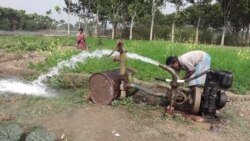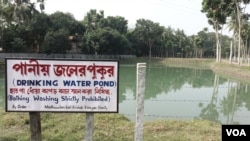Farm laborer Gostha Das drank contaminated water for years.
That is not unusual for someone living in a village in the middle of eastern India’s arsenic belt, but it still carries real dangers where arsenic-rich groundwater has maimed and killed people since the 1970s.
About a decade ago, when he sought medical treatment for lesions on his palms and feet, Das was told he was suffering from arsenicosis, which can cause skin lesions, as well as cancers of the skin, lungs, kidneys and bladder and many other diseases. Doctors advised him to stop drinking the groundwater immediately. Yet he kept on drinking the contaminated water because he could not afford to buy regular bottled water.
Das is happy now because of a new initiative by Delhi-based NGO Sulabh International Social Service Organization (SISSO) to treat pond water and use it to provide safe and affordable drinking water in his village of Madusudankati, 70 kilometers east of Kolkata. “Groundwater drawn from tube-wells filled my body with poison and I got the lesions. I had no money to buy safe bottled water, which was expensive. But from Sulabh, I am getting clean water at very cheap price now. This water has kept me fine,” he said.
He added that some villagers have secretly had the water tested in labs, which found it to be free from all contaminants, including arsenic.
SISSO founder Bindeshwar Pathak said his organization had been encouraged by the success of the pilot project in Madhusudankati and would try to come up with more such surface water treatment plants across the country’s arsenic-zones. "We will certainly expand. Now there is demand of such projects from many states after they heard of the news of success of this project from West Bengal,” Pathak said. “We have to certainly go with such projects throughout the country.”
Cheap solutions
While one liter of regular bottled water sells at 7 to 22 cents in the market. The treated pond water, which is supplied by Sulabh, costs less than a cent per liter. Sulabh water has now become a life line in a cluster of about a dozen villages of West Bengal’s arsenic belt.
In the 1960s, as the drilling of tube wells began in eastern India, people were advised to switch to the practice of drinking groundwater, to protect themselves from cholera and other water-borne epidemics.
But the switch from traditional dug wells to tube wells proved fatal in the 1990s, when a high level of arsenic contamination was detected in water from tube wells in Bangladesh and in eastern India.
After doctors warned that millions of people in West Bengal were drinking arsenic-contaminated groundwater, the local government set up many arsenic removal plants. But, most of those plants in West Bengal having turned virtually dysfunctional for many reasons. For years, many experts have suggested using treated surface water as an easy solution to the drinking water problem in the area. But the advice was largely ignored, until recently.
The Sulabh water project, which SISSO set up with assistance from the French NGO 1001 Fontaines, began feeding its modern treatment plant with only pond water.
Push for more plants
Pond water is traditionally meant for washing and bathing in the region and local residents usually avoid drinking it because it is frequently contaminated.
In West Bengal’s arsenic belt, this is the first such project based on pond water and it has been quite successful in addressing the local drinking water crisis, said Kalipada Sarkar, secretary of the village cooperative that manages the Madhusudankati water treatment plant.
“People in the surrounding villages have found Sulabh water beneficial for their health and they have widely accepted it. Villagers from far-off areas too are seeking access to this treated pond water now. But the capacity of our Madhusudankati project is limited,” said Sarkar. “We want others to set up many identical pond-based drinking water projects across the state’s arsenic belt.”
Sulabh water has brought relief for the mostly poor people in arsenic-hit Madhusudankati and about a dozen surrounding villages, said local doctor Subal Sarkar.
“Since people had been drinking arsenic-contaminated groundwater for years, arsenicosis cases of skin, liver, kidney, ulcerations in elementary systems were rising among the villagers. However, after they switched to the practice of drinking arsenic free Sulabh water last year, many arsenicosis patients are recovering gradually,” said Dr. Sarkar. “[The] number of new cases of arsenicosis has also dropped significantly.”
Contaminated groundwater still being consumed
In 2010, Jadavpur University's School of Environmental Studies (SoES) reported that in West Bengal at least five million people were drinking water with arsenic contamination at 50 ppb (parts per billion), five times higher than the World Health Organization's suggested limit of 10 ppb.
In a report last month, the Central Ground Water Board (CGWB) said most of the arsenic removal plants were becoming dysfunctional in West Bengal, with a huge population of people being forced to drink water contaminated with a “dangerous level” of arsenic.
Contaminated groundwater is also being used to irrigate food crops, and arsenic is entering the food chain in the region, the CGWB report added.
Dipankar Chakraborti, a professor and research director of SoES who has been working on arsenic contamination of groundwater since the 1980s, said groundwater should be avoided in West Bengal’s arsenic belt.
"All across West Bengal there are many ponds and other water bodies. In the arsenic belt the only solution, [where] the technology is known now, is use of the surface water. We should all adopt the simplest way, easy way, to clean the available surface water for [this] purpose,” Chakraborti said.









